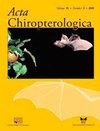Exotic Cultivated Plants in the Diet of the Nectar-Feeding Bat Glossophaga soricina (Phyllostomidae: Glossophaginae) in the City of Lima, Peru
IF 0.7
4区 生物学
Q4 ZOOLOGY
引用次数: 4
Abstract
While the presence of some phytophagous bats species in Neotropical cities is generally known, detailed information on their feeding habits in urban ecosystems is still limited. In some highly developed urban spaces, native plant species are scarce, therefore phytophagous bats living in those conditions could be relying only on resources offered by introduced vegetation. This study describes the diet of Glossophaga soricina in the campus of Universidad Nacional Agraria La Molina in the city of Lima, Peru. To achieve this, from September 2016 to May 2017, bats were captured using mist nets to collect samples of feces and pollen from their body surface. The phytophagous diet of G. soricina comprised resources offered by at least 25 species of cultivated plants, nearly all of them introduced to Lima. Glossophaga soricina mainly fed on the nectar/pollen of Agave angustifolia, Eucalyptus spp., Crescentia cujete and Musa spp., and fruits of Piper aduncum and Morus nigra. Insects were also registered in its diet. It consumed many non-chiropterophilous flowers and most of its principal resources are not abundant in the study area. Results suggest that G. soricina is a generalist nectarivore that has adapted its dietary habits to consume nectar/pollen of a wide variety of flowers and complements its diet with fruits and insects. It is concluded that introduced cultivated vegetation permits the persistence of G. soricina in the city; hence unsuitable green areas management could negatively affect its local populations. More studies on ecology of urban phytophagous bats in Lima and other Neotropical cities are required to conserve their populations in those altered ecosystems.秘鲁利马市以花蜜为食的蝙蝠舌苔(Phyllostomicae:舌苔亚科)日粮中的外来栽培植物
虽然人们普遍知道一些植食性蝙蝠物种在新热带城市中的存在,但关于它们在城市生态系统中觅食习惯的详细信息仍然有限。在一些高度发达的城市空间中,本地植物物种稀少,因此生活在这些条件下的植食性蝙蝠可能只依赖引入的植被提供的资源。这项研究描述了在秘鲁利马市的国家农业大学校园里的索里奇纳舌苔的饮食。为了实现这一目标,从2016年9月到2017年5月,蝙蝠被用雾网捕获,从体表收集粪便和花粉样本。soricina的植食性饮食包括至少25种栽培植物提供的资源,几乎所有这些植物都被引入利马。soricina舌苔主要以狭叶龙舌兰、桉树、朱顶和穆萨的花蜜/花粉为食,以及胡椒和黑桑果。昆虫也登记在它的饮食中。它消耗了许多非亲翼龙的花朵,而且在研究区域内,它的大部分主要资源并不丰富。研究结果表明,索里奇纳是一种多面手食蜜动物,其饮食习惯已适应于食用各种花朵的花蜜/花粉,并以水果和昆虫为补充。结果表明,引入栽培植被可以使毛霉菌在城市中持续存在;因此,不适当的绿地管理可能会对当地人口产生负面影响。需要对利马和其他新热带城市的城市植食性蝙蝠的生态学进行更多的研究,以保护它们在这些改变的生态系统中的种群。
本文章由计算机程序翻译,如有差异,请以英文原文为准。
求助全文
约1分钟内获得全文
求助全文
来源期刊

Acta Chiropterologica
生物-动物学
CiteScore
2.50
自引率
20.00%
发文量
42
审稿时长
>12 weeks
期刊介绍:
Acta Chiropterologica, published by the Museum and Institute of Zoology at the Polish Academy of Sciences, is devoted solely to the study and discussion of bats.
 求助内容:
求助内容: 应助结果提醒方式:
应助结果提醒方式:


